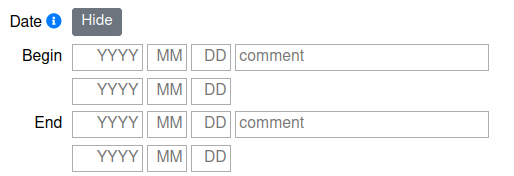Date
CIDOC based OpenAtlas shortcuts: OA8 (begins in) and OA9 (ends in)
Date input fields in forms are initially hidden and can be shown after clicking on the Show button next to the Date label.
To manage uncertainty in time up to four dates can be used: a time span for the beginning with start and end date as well as and a time span for the end, also with a beginning and end date. Find detailed examples here: Time Spans

Exact date
If you know the exact birth of an actor you could enter 1356-12-23 in the first row of the date field.
Time span
If you are unsure when e.g. a Church was destroyed, you can use both end dates to enter a timespan. Chose a wide enough range to make sure the event lies in between those dates with 100% certainty. So, to record a date within the fist decade of 1800, enter: * 1800 into the first end row of the date field * 1809 into the second end row of the date field
Days and months are filled in automatically if not stated by you. The result will therefor be 1800-01-01 to 1809-12-31.
Autocomplete dates
If a date but not an exact date was entered into the form, the system automatically creates a time span. For example, if only a year is entered in the first row, a timespan of this year will be saved. For example:
800 will generate: 800-1-1 to 800-12-31.
800-5 will generate 800-5-1 to 800-5-31
Input values
Year: -4713 to 9999 but not zero
Month: 1 to 12
Day: 1 to 31
Comment: add additional information for begin or end
Additional fields for hour, minute and second appear if the time module is activated in the Profile or if that information was already entered for that entity:
Possible values:
Hour: 0 to 23
Minute: 0 to 59
Second: 0 to 59
Background
Dates will be validated so you can just try if you aren’t sure about a leap year or similar. Most limitations come from the database PostgreSQL which in turn uses the Proleptic Gregorian calendar. So there is no year zero (one year before year 1 is the year 1 BC) and dates before the year 4713 BC can not be recorded.